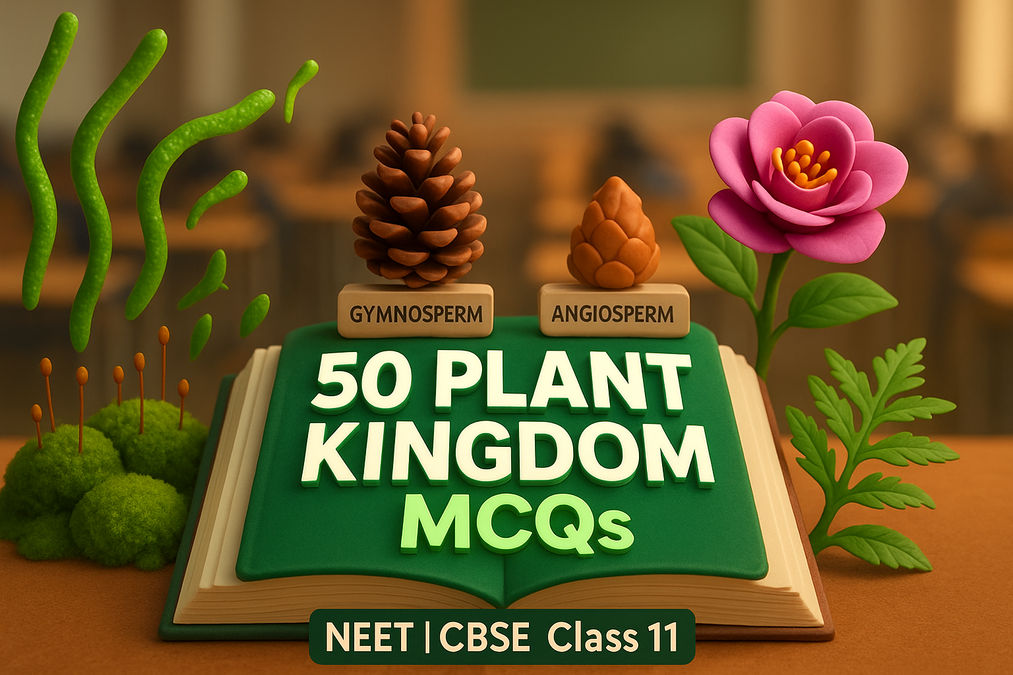50 Plant Kingdom MCQs: Test Your Knowledge on Algae, Bryophytes

50 Plant Kingdom MCQs: Test Your Knowledge on Algae, Bryophytes & More!
Meta Description: Practice with 50+ multiple-choice questions on the Plant Kingdom (Algae, Bryophytes, Pteridophytes, Gymnosperms, Angiosperms) with detailed answers. Perfect for NEET, CBSE, and competitive exams!
Section 1: Algae
1. Which pigment gives red algae its distinctive color?
2. Algin, a hydrocolloid, is obtained from:
3. Volvox exhibits which type of sexual reproduction?
4. Storage body in Chlorophyceae chloroplasts is called:
5. Which algae is used as a food supplement by astronauts?
6. The cell wall of green algae contains:
7. Which of these is a colonial green alga?
8. Carrageenan, used in food industry, comes from:
9. Fucoxanthin pigment is characteristic of:
10. Which algae grows at the greatest ocean depths?
Section 2: Bryophytes
11. Bryophytes are called "amphibians of the plant kingdom" because:
12. The dominant phase in the bryophyte life cycle is:
13. Peat moss, used as fuel, belongs to:
14. Gemmae cups are found in:
15. Mosses prevent soil erosion by:
16. The leafy stage in mosses develops from:
17. Which structure produces antherozoids in bryophytes?
18. The sporophyte of bryophytes is:
19. Which bryophyte has a dorsiventral thallus?
20. Moss sporophyte consists of:
Section 3: Pteridophytes
21. The first vascular plants are:
22. Heterospory is observed in:
23. Prothallus in ferns is:
24. Pteridophytes require water for:
25. Strobili are found in:
26. The first terrestrial plants to develop vascular tissue were:
27. Which pteridophyte is commonly called "horse tail"?
28. The evolutionary significance of heterospory is:
29. Fern leaves are called:
30. Which of these is a homosporous pteridophyte?
Section 4: Gymnosperms
31. Naked seeds are characteristic of:
32. Tallest gymnosperm is:
33. Pollen grains in Pinus have:
34. Coralloid roots host:
35. Gymnosperm leaves are adapted to reduce water loss by being:
36. Which gymnosperm is considered a living fossil?
37. The edible part of Pinus seed is:
38. Which gymnosperm has unbranched stems?
39. The wood of gymnosperms lacks:
40. Taxol, an anti-cancer drug, is obtained from:
Section 5: Angiosperms
41. Double fertilization occurs in:
42. Monocots have:
43. Edible part of mango is:
44. Which is NOT a dicot feature?
45. Most advanced plant group is:
46. Double fertilization produces:
47. Which plant shows parallel venation?
48. The fruit develops from:
49. Which is a monocotyledonous plant?
50. Angiosperms dominate because of:
Answer Key & Explanations
1. c – R-phycoerythrin in Rhodophyceae.
2. a – Algin from Phaeophyceae (brown algae).
3. c – Oogamy in Volvox (large non-motile egg + small motile sperm).
4. b – Pyrenoids store starch in Chlorophyceae chloroplasts.
5. b – Chlorella is rich in proteins and used as space food.
6. b – Green algae have inner cellulose and outer pectose cell wall layers.
7. a – Volvox forms spherical colonies of cells.
8. c – Carrageenan is extracted from red algae like Chondrus.
9. b – Fucoxanthin gives brown algae (Phaeophyceae) their color.
10. c – Red algae can photosynthesize in deep water due to phycoerythrin.
11. b – Bryophytes require water for sexual reproduction.
12. b – Gametophyte is dominant in bryophytes.
13. b – Sphagnum moss forms peat used as fuel.
14. b – Liverworts like Marchantia reproduce asexually via gemmae cups.
15. a – Moss mats protect soil from water and wind erosion.
16. b – Secondary protonema gives rise to leafy gametophores.
17. b – Antheridia produce male gametes (antherozoids).
18. b – Bryophyte sporophytes depend on gametophytes for nutrition.
19. b – Marchantia thallus shows distinct dorsal and ventral surfaces.
20. c – Moss sporophyte has foot (attachment), seta (stalk), and capsule (spore producer).
21. c – Pteridophytes were the first vascular plants.
22. b – Selaginella produces both microspores and megaspores.
23. a – Prothallus is the free-living gametophyte generation.
24. b – Water is needed for sperm to swim to archegonia.
25. a – Equisetum bears cone-like strobili for spore production.
26. b – Pteridophytes were first to develop xylem and phloem.
27. b – Equisetum resembles a horse's tail.
28. b – Heterospory led to evolution of seeds in higher plants.
29. b – Fern leaves are called fronds (megaphylls).
30. c – Dryopteris produces only one type of spore.
31. b – Gymnosperms have naked seeds.
32. b – Sequoia sempervirens can grow over 100m tall.
33. a – Air sacs help pine pollen float on wind currents.
34. b – Cycas coralloid roots host Nostoc/Anabaena cyanobacteria.
35. b – Needle leaves (e.g., pine needles) minimize surface area.
36. c – Ginkgo biloba has remained unchanged for millions of years.
37. a – Pine nuts are the female gametophyte tissue.
38. a – Cycas has a palm-like unbranched stem.
39. b – Gymnosperm wood contains only tracheids (no vessel elements).
40. b – Taxol from Taxus bark treats ovarian and breast cancers.
41. c – Double fertilization is unique to angiosperms.
42. b – Monocots have fibrous root systems (vs. taproots in dicots).
43. b – The fleshy mesocarp is the edible part of mango.
44. c – Single cotyledon is characteristic of monocots, not dicots.
45. b – Angiosperms are most evolved due to flowers and fruits.
46. b – One sperm fertilizes egg (zygote), another forms triploid endosperm.
47. c – Wheat (monocot) shows parallel leaf venation.
48. b – Fruit develops from the mature ovary wall (pericarp).
49. c – Maize is a monocot (single cotyledon, parallel veins).
50. a – Flowers enable efficient pollination, fruits aid seed dispersal.
Note: For the complete set of 50 questions with detailed explanations, download our PDF guide.
Join the conversation